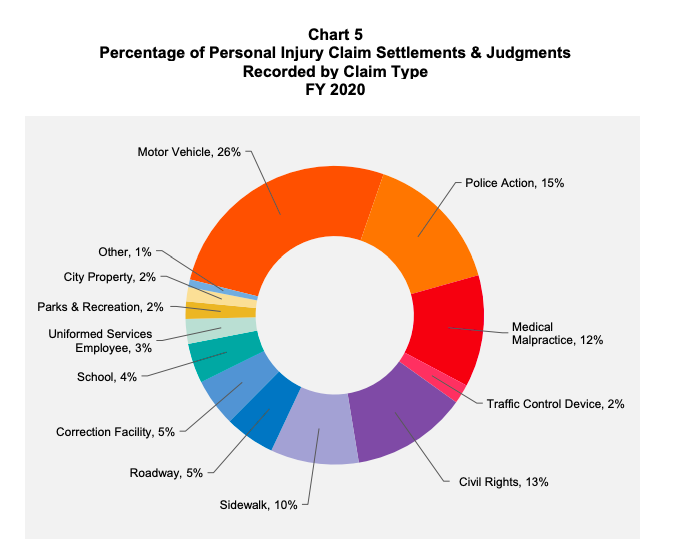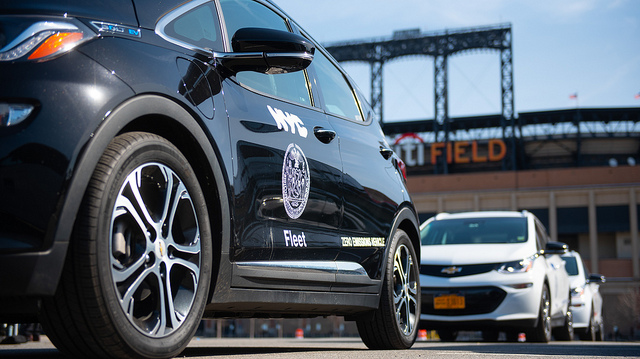Injuries caused by city employees behind the wheel of their taxpayer-funded government cars cost the city close to $150 million in settlements last year — 33 percent more than they did just one year earlier, a new report shows.
The $142.4 million that the city paid out in settlements during Fiscal Year 2020 — which covers July 1, 2019 to June 30,2020 — is the result of 1,390 claims filed by people injured by the on-the-job driving practices of city employees. The raw number of claims was up just 3 percent, from 1,350 during FY2019, according to the annual report from the Comptroller's office.
The total number of personal injury claims against the city for went down last year for the third consecutive year — from 16,713 in fiscal year 2019 to 15,553 in 2020 — so the injuries caused by motor vehicle crashes stand out. Comptroller (and mayoral candidate) Scott Stringer attributed that partly to the COVID-19 pandemic that began last March and started a period with very little car travel.
“The pandemic took an unimaginable toll on our neighbors and loved ones, small businesses, and the way we all work and live. Protecting and strengthening the city’s fiscal health is now more important than ever to make a strong economic recovery,” said Stringer.
Fiscal Year 2020 was the fourth consecutive fiscal year that the city had to pay victims more than $100 million for crash settlements, according to the report.
And compared to 2011, the number of claims filed against the city for injury-causing motor vehicle crashes has remained relatively stagnant (1,307 vs. 1,390) compared to the decline in claims filed for police action (4,521 vs. 3,879) or for civil rights violations (3,079 vs, 1,156), according to the report.
As Streetsblog has previously reported, motor vehicle crashes caused by city employees is a huge burden on city taxpayers, accounting for 26 percent, the largest portion, of all claims filed against the city. Settlements for injuries caused by cops came in second at 15 percent, or $82.6 million, according to the report.
That burden represents scores of improvements the city can't make because of limited resources, activists say.
"[It] amounts to a staggering $1 billion in just over seven years, and shows that our city is negligent in protecting New Yorkers," said Transportation Alternatives Deputy Director Marco Conner DiAquoi. "If we were to invest such amounts to truly give our streets back to New Yorkers (as called for in TA's Vision Zero Street Design Standard in 2016, self-enforcing streets report in 2020, and NYC 25x25 challenge in 2021), that investment would pay for itself in the long run in preventing the need for these tort costs, and create a better, more equitable, and safer city."

In FY2020, the number of claims for injuries caused by police action also rose seven percent from fiscal year 2019 — from 3,614 to 3,879 — in 2020, but unlike motor vehicle settlements, the total payout went down 15 percent from $97.3 million in 2019 to $82.6 million in 2020, according to the report.
It’s not entirely surprising given that another epidemic that took off during the city’s shutdown — speeding — led to an increase in motorist deaths and crashes. And in 2019, Streetsblog reported that city employees were getting into more preventable and injury-causing collisions while behind the wheel of their taxpayer-funded government cars.
City Hall focused on the positive — pointing out that the total number of crashes was down.
"We continue to prioritize and push fleet safety as part of Vision Zero, and the number of crashes and injuries have gone down," said mayoral spokeswoman Laura Feyer. "Initiatives include: training over 68,000 staff in all day fleet safety training, including adding an online course for that last year with already over 5,000 participants. We have also placed nearly 60,000 safety improvements on fleet units including telematics, back-up cameras, truck side-guards, automatic braking, and driver alert systems. We also require all new vehicles to be specified and purchased with the highest level of safety through out Safe Fleet Transition Plan."
Claims payouts in the comptroller's report can reflect injuries that happened in prior years. Total crashes by city employees dropped from 6,061 in Fiscal Year 2019 to 4,752 in FY2020, and reported injuries decreased from 827 to 560.






